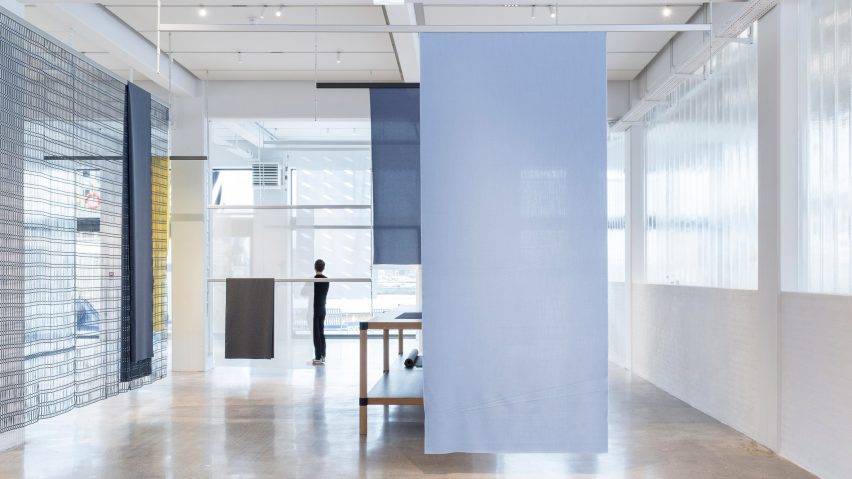French designers Ronan and Erwan Bouroullec have designed a predominantly white Copenhagen showroom for Danish textile brand Kvadrat, so that the fabrics can take centre stage.
Located within a former cargo building in Copenhagen's industrial Nordhavn neighbourhood, the light-filled showroom has large windows on three sides, which offer panoramic views of the city and harbour.
The Bouroullec brothers wanted to give Kvadrat a space with "no colours, just materials" – to celebrate the quality of fabrics produced by the world-leading brand, which ranked at 180 on the inaugural Dezeen Hot List.
To achieve this, they paired an all-white colour palette with natural materials such as oak and concrete flooring. They then furnished the space with desks made from Really Solid Textile Boards – a product made by Kvadrat-owned brand Really.
Two brick walls topped by transparent glass screens run parallel through the heart of the space, creating a layout with a bright gallery area in the centre, office areas on one side, and shelving for textiles and rugs on the other side.
A conference room, kitchen, reception, bathrooms and IT room are also integrated into the space, partitioned by extruded glass partition walls.
These glass screens and walls reflect the weather conditions outside of the building.
"The concept we developed is focused on materiality, which is at the heart of the Kvadrat brand," explained Erwan Bouroullec.
"Fabrics are wonderful because most of the time their appearance naturally flows from their making," he continued. "They are all the colours and structures of the yarns. That is what we wanted to make visible, taking the natural atmosphere of the space as a background."
The studio's textiles and rugs are hung throughout the gallery space on height-adjustable rails. These are attached to a gridded track on the ceiling that is lined with rows of Kvadrat Soft Cells acoustic textile panels.
The same anodised and milled aluminium parts that make up the rail system are used to create heavy-duty shelving for storage and display.
Using the versatile system, large areas of the space can be completely cleared or populated with textiles, rugs and installations.
"The showroom aims to deliver total flexibility to create scenes with large pieces of textiles and rugs," said Erwan Bouroullec. "Doing so provides a deep insight into the weave, weight, transparency and quality of each design."
The showroom furniture is mostly custom made and includes pieces designed by Bouroullec Studio for Vitra, such as the Alcove Plume sofas, Belleville armchairs, Tyde tables and Cyl high tables. Tiles designed by Bouroullec Studio for Mutina are used in the bathrooms.
All the seating inside the showroom is upholstered in Kvadrat's Basel and Hallingdal 65, while the outside spaces are furnished with tables and chairs from the Studio's galvanised steel Pallisade outdoor collection for Hay.
This Copenhagen showroom marks the Parisian designers' third showroom design for Kvadrat, following the brand's previous showroom in Copenhagen and one in Stockholm.
The design duo have also created numerous products for the Danish brand including a modular room-dividing system called Clouds, a DIY kit for making curtains called Ready Made Curtain, a collection of Roller Blinds, several textiles and a rug.
"More than 10 years ago we opened the Stockholm showroom, which at the time was a statement of how fabric could be used to practice interiors design," reflected the designers.
"Through the years, our approach to Kvadrat as a textile manufacturer evolved. This evolution come naturally from a deeper relationship, and many projects we handled together, but also from a sensation that in contemporary culture the understanding of 'materiality' become an increasing challenge."
"Our new showroom is a symbol of the journey we have been on during this period," added Njusja de Gier, Kvadrat's vice president of branding and communication, who led the project alongside CEO Anders Byriel and exhibition manager Jacob Manz.
"We are very excited with the Bouroullec's concept because it allows us to explore space and materiality again in new ways."
Photography is by Michel Giesbrecht.

